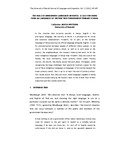| dc.description.abstract | In the situation that currently prevails in Kenya, English is the
prestigious language, the mastery of which is a prerequisite for social
and economic advancement. Kiswahili, for its part, as the national
language of Kenya and now an official language alongside English, is used
for communication between people of different ethnic groups, in the
courts, in the lower primary school, as well as in such areas as the
market, the neighbourhood, the transport industry and work. As for the
other indigenous languages of Kenya than Kiswahili, they are used in the
family, the local community, lower primary school, adult literacy
courses, the church, the media, and at the work place. This paper, while
recognizing the huge challenges that would be involved, argues for the
use of these indigenous languages as languages of instruction beyond the
lower primary school, that is up to at least the end of primary school.
This would ensure that they are more stable languages capable of being
used more productively by the learners later in life in both their further
education and their professional lives. | en_US |


